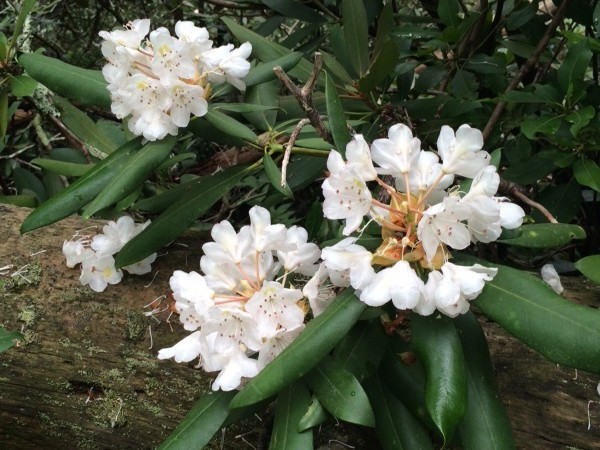
Did you know that there are more than 1,000 species of rhododendron in the world? Can you name the four species we have in the Smokies?
I learned these things and more when I edited an article by Courtney Lix for publication in the current issue of Smokies Life. Courtney’s story provides insight into this ubiquitous and resilient plant—one that might easily be taken for granted by locals and repeat visitors to the park.
“The most common is the rosebay (R. maximum), which grows most abundantly at lower elevations but can be found nearly everywhere throughout the national park,” Courtney wrote. “Small-leaved rhododendron (R. minus) occurs frequently as well, although in smaller numbers than rosebay. The other two rhododendron species grow in mid- and high elevations, mostly above 3,500 feet: the Carolina rhododendron (R. caroliniana), and Catawba rhododendron (R. catawbiense).”
A native of eastern Kentucky, I am most familiar with the Catawba variety, which was discovered in North Carolina by French botanist and explorer Andre Michaux in the late 1700s. Thanks to Courtney, I’m beginning to recognize the other types while hiking.
“As I started working on the article, I realized I’ve seen rhododendron everywhere in the mountains, for my whole life—but I actually knew very little about why they were so common or what role they play in the Smokies ecosystem,” said Courtney, who grew up in Gatlinburg, TN. “Talking with Kris Johnson and Glenn Taylor about them was very eye-opening!”
While researching the story, Courtney learned that even though it’s still too early to make any definitive statements about ecological changes caused by the November 2016 fires, it’s clear that the rhododendron in areas that burned hottest are having a tougher time sending up new shoots.
“Since it is such a common species, whether it can regrow or not will have a significant effect on what the future forest is like,” she said.
You may recognize Courtney’s name because, in addition to writing many other Smokies Life articles, she authored Women of the Smokies, as well as the award-winning Frequently Asked Questions about Smoky Mountain Black Bears, both published by Great Smoky Mountains Association. She honed her writing while studying biology at Princeton and is now a full-time editor at Island Press in Washington, D.C., and a faculty member of Columbia University’s Publishing Course.
Looking back over her GSMA work, “nothing compares to the research and writing of Women of the Smokies,” she said. “On the surface, the women’s lives were so different—a Civil War widow, a Cherokee potter, an international superstar, to name a few—but they have more in common than you’d think. It was fun to discover those connections, and I got to know a number of fascinating and wonderful people while working on the book.”
Of the Great Smoky Mountains Association books written by other authors, The Civil War in the Smokies by Noel Fisher is one of Courtney’s favourites.
“He’s a compelling storyteller who vividly describes what was at stake in the mountains for the North and South writ large, and also for the folks who were caught in the lawlessness enabled by such a remote and difficult landscape,” she said. “It gave me a new perspective on both the Smokies and the war, and I’ve referred to it for a few different pieces I’ve written.”
Subscribe to get the latest posts sent to your email.
The Great Smokies Welcome Center is located on U.S. 321 in Townsend, TN, 2 miles from the west entrance to Great Smoky Mountains National Park. Visitors can get information about things to see and do in and around the national park and shop from a wide selection of books, gifts, and other Smokies merchandise. Daily, weekly, and annual parking tags for the national park are also available.